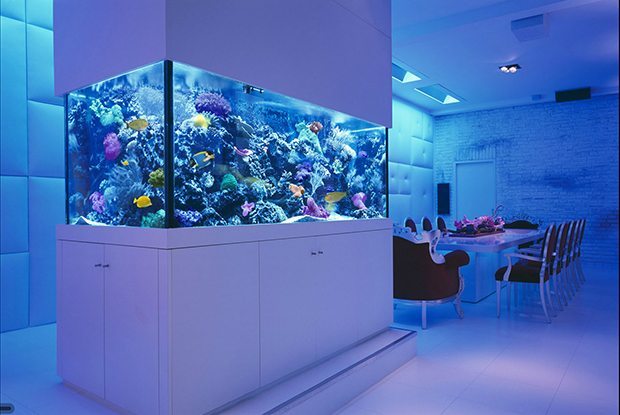
The ultimate in residential eye candy—a custom-built aquarium is simply a showstopper. What you need to know before taking the plunge
by matt Scanlon
If the reader is anything at all like this author, he or she has never quite gotten over the wide-eyed childhood thrill of watching their first betas, angelfish, or seahorses coursing around in a dimly-lit, algae-strewn home aquarium–one that was never quite cleaned to anyone’s satisfaction (likely including its occupants), but nevertheless provided wide stretches of discovery and wonder.
As our homes and ambitions mature and broaden, it’s reasonable to expect a corollary uptick in aquarium dimension, and while there is a vigorous and growing marketplace in “nano systems,” ones in which a prepackaged and self-contained aquatic biological community can be created and sustained in as little as a 5-gallon tank, for the purposes of this article, the idea was to think big.
For both maximum biological and design punch, we wanted to start the journey in the 300-gallon-and-up range (approximately 6 feet long by 30 inches high by 24 inches deep), and so went to one of the borough’s most passionate aquatic design enthusiasts–Noel Rose, founder of Anchor Aquarium Service in Bushwick. After a stint as a life-support specialist at the Nashville Zoo in Tennessee, he founded his “biological installation company” in 2005, and has since both designed and installed tanks that can exceed 1,000 gallons—ones that embrace everything from purely aesthetic coral/water sculptures to full-on “reef tanks” self-contained little worlds that combine a variety of synergistic and symbiotic types of fish, invertebrates, and corals.
“Oh, the holy Grail? That would definitely be a reef tank,” Rose said with a smile. “It’s a complete ecosystem—a saltwater environment that combines fish, rock covered with trillions of bacteria to help filtration, snails, crabs, and sea stars that help clean and filter sand and other parts of the tank…plus corals and the fish themselves. They are simply gorgeous things.”
Gorgeous, and on their face, often frustratingly complex. Custom-designed tanks of this type, which are frequently requested for commercial placement but are increasingly attractive to home buyers looking for the ultimate in eye candy–require increasingly 21st-century types of technology in order to function reliably, along with a designer/installer that manages to combine left brain and right brain activities simultaneously.
First, reef tanks of this considerable scale need to be kept at a relatively steady 77°F. In a home that averages 72°, this temperature can be achieved through the additional kinetic energy of the pumps along with any overhead or other lighting, but particularly in large tanks, assistance is often required. It’s not uncommon to have both heaters and chillers working dynamically to “sort of battle each other,” Rose explained. Both heater and chiller will also often have redundancy built-in, too; if one pump fails, there’s another at the ready. It’s not uncommon for large systems to also have power backups via an external generator.
“If you have $30,000 invested in the tank and its animals, there’s just no way you’ll want to start over in the event of a power failure,” said Rose.
Technology can also come to the aid of those in search of a more interesting and dynamic tank. A number of companies, such as Neptune Systems, offer temperature control that is available to aquarium owners—anywhere in the world—through an Android or iOS device. “There are systems of this type that can control lighting, temperature of course, and even feed your fish for you,” Rose said. “It can get a little bit obsessive compulsive, this kind of interaction, but it’s also great fun.”
As for the kind of fish one should select, the choices are as varied as a buyer’s taste, but can, in a reef tank, start as little as $50 for individual animals, then rise rapidly up the price food chain.
“Wrasses are very popular, and there are dozens of species of them,” said Rose. “Lineatus Wrasse, for example: a really nice mail/ female pair can cost you $500 to $800. They are smaller but just spectacularly colored fish. You can also get a Neso Tang or Unicorn Tang that’s eight inches long, and it would only be $250 or $300, and too many choices in between to even begin to describe.”
“One initial and often frustrating thing I discuss with potential buyers is that it is very much my preference to be the person who both designs the ecosystem and stocks it,” Rose added—a stocking procedure that includes picking fish species that have their own individual “jobs” (cleaning, etc) to other beneficial and complementary species within the tank, down to water treatment and replacement, and finally making sure that new arrivals are properly screened for harmful bacteria or other organisms. All these considerations and installation efforts come as a relief to some buyers who simply want everything to look stunning, but can be frustrating for hands-on enthusiasts who like to stock their own tanks with an unexpected find at the nearby pet store.
“It’s almost inevitable—someone will go to a PetCo and find something colorful and stunning that they will introduce into the tank, and then a week later call me and ask why so many of the fish are sick or dying,” Rose explained, adding that any species introduced into the self-contained system need to be properly treated and graduated into the water environment of the tank, among other preconditions.
An investment of approximately $20,000 in a six-foot tank almost always involves some sort of monthly service, too, sometimes as often as twice a week for very large tanks or for owners who want a minimum of interaction. Water changes, filter changes, a general inspection, and other work requires usually two hours minimum per visit, and Anchor Aquarium Service charges $90 per hour (other vendor prices vary, of course). Monthly expenditures for service and equipment for a 400-gallon tank might hover in the $1,000 range.
As for installation, in-wall systems can often be a thrifty choice, particularly if there is a closet or some other unoccupied space behind the tank site that can be utilized for filter and other equipment.
Peninsular installations—those that jut into the room—typically require more custom cabinetry, and can quickly jump past the $30,000-$40,000 range.









